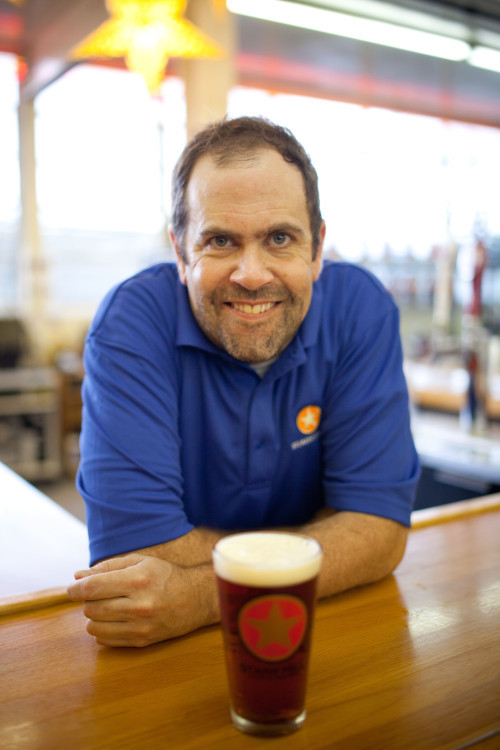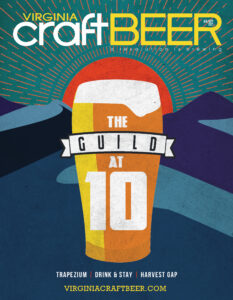
By Mark Thompson
August is Virginia Craft Beer Month, a time that celebrates the world class beers coming out of the Commonwealth. During the entire month of August many of the 80-plus craft breweries in the state rejoice in the occasion to showcase their craft. The month culminates with the Virginia Craft Beer Festival in Nelson County.
As part of the Virginia Craft Beer Festival, there is a judged competition that is named the Virginia Craft Beer Cup. “The Beer Cup” as it is affectionately called by many of the state brewers is held to recognize excellence in Virginia beers. In its third year, this event is hosted by the Virginia Craft Brewer’s Guild which is a coalition of independent small, commercial breweries dedicated to growing the craft beer industry in the Commonwealth.
There are larger competitions such as The World Beer Cup and Great American Beer Festival, both of which are hosted by the Brewers Association. The Brewers Association is the national trade group for craft breweries whose purpose is to promote and protect small and independent American brewers, their craft beers and community of brewing enthusiasts. The World Beer Cup judges beers from all over the world, while the Great American Beer Festival judges beers from America.
The unifying theme for any competition is to assign some form of quality ranking to the individual beers entered into the competition. The style categories may vary from state, national, or international competitions but the process of narrowing the field to award Gold, Silver and Bronze medals are universal.
Virginia Beer Cup
The Virginia Beer Cup (VBC) is a statewide competition and uses the competition guidelines set out by the Beer Judge Certification Program (BJCP). The BJCP is the standard bearer for most amateur beer competitions, including the American Homebrewer Associations sanctioned events. The BJCP was founded in 1985 and has administered the Beer Judge Examination to nearly 8,000 individuals worldwide. The BJCP certifies and ranks beer judges through an examination and monitoring process, sanctions competitions, and provides educational resources to current and future judges. The BJCP recognizes 23 unique beer styles that range from Light Lager to Belgian Strong Ale. A complete listing of the styles can be found at bjcp.org/2008styles/catdex.php.
Tom Cannon, who lives in Northern Virginia, is the acting competition organizer for the Virginia Craft Beer Cup. Tom is an officer with the BJCP and the acting Exam Administrator for the organization. He is ranked as an Advanced Grand Master Level 2 judge with the organization. When asked how he got into Craft Beer, he jokingly said, “College.” That and some time spent in England was what sent him on his 20-plus year craft beer journey. Tom first took the BJCP exam in 1994 and has continued with his involvement ever since.
According to their website, “The BJCP’s mission is to encourage knowledge, understanding and appreciation of the world’s diverse beer, mead, and cider styles. To promote, recognize, and advance beer, mead, and cider tasting, evaluation, and communication skills, and develop standardized tools, methods, and process for the structured evaluation, ranking and feedback of beer.”
The 2013 Virginia Beer Cup featured 132 beers from around the state from 31 different breweries. Gold, Silver, and Bronze medals were awarded in 14 different style categories. From the 14 Gold medal winning beers, a ‘best of show’ was selected to represent the best of the best for that year in Virginia. Commenting on this year’s competition Tom stated, “I expect this year’s Virginia Beer Cup will be much larger than last. I am expecting there to be over 200 beers from 40 or more breweries.”
World Beer Cup/Great American Beer Festival
The World Beer Cup (WBC) and Great American Beer Festival (GABF) are two of the largest and most recognized beer competitions in the world. Both events are judged in the same manner as the Virginia Beer Cup, except that the GABF evaluate beers that are brewed in America and the WBC with beers from across the world.
The Great American Beer Festival is held in Denver, Colorado in late September or early October every year. The GABF was founded in 1982 and featured nine breweries the first year. The World Beer Cup is held every other year in conjunction with the Craft Brewer’s Conference which travels to different cities throughout the United States. Both of these competitions are judged under the beer style guidelines set forth by the Brewer’s Association.
Unlike the Beer Judge Certification Program (BJCP) which recognizes 31 beer style categories, the Brewer’s Association has expanded its number of styles quite considerably. The WBC recognizes 94 distinct style categories and the GABF recognizes 90 categories. The individual style categories are arranged into three large groups consisting of Lager Beers, Ales, and Hybrid or Mixed style. The Lager and Ales are then further defined based on the country of origin for that particular style. A couple of examples would be Scottish Ale and American Lager.
Regardless of the number of style categories, the beers are evaluated to determine excellence of each category with the recognition of gold, silver and bronze medals. When asked for comment Chris Swersey, the Competition Manager for the Great American Beer Festival and World Beer Cup competitions, stated, “Evaluating beer happens on many levels. On a professional level, beer evaluation is a form of peer review. The results are public, so consumers can learn what beers meet a high level of quality and what beers exemplify certain styles as interpreted by the judges. When industry professionals acknowledge the excellence in products from around the market, the consumers can be sure that those products are the finest available.” Chris has served as the Competition Manager for the WBC and GABF since 2002.
Mechanics of Judging
The mechanics of how professional beer competitions are held vary slightly from event to event but all share the common principle of evaluating the quality of an individual beer as it relates to a specific style criteria. Each competition starts with a set of beer style guidelines that define the flavor attributes of that particular style. In the description of a given style, parameters are established on the original gravity, finial gravity, and alcohol by weight/volume, bitterness, and color the beer should have. For most beer styles, the parameters are well defined and give a range from low to high for that particular style. For example American Amber Ales have a range in alcohol by volume from 4.5 – 6 %.
Each style also has a written description that details the flavor attributes of that particular style in more detail. The written description for each style clearly establishes the intensity of flavors for each style of beer. These descriptions may describe the intensity of hop bitterness or aroma, the amount of perceived Carmel malt flavor, if chill haze is allowable, noticeable fruit flavors, and other flavor attributes that are appropriate for the style.
Regardless of the competition, participating breweries enter their beers into the category that they feel best represents the product that they make. The process of deciding what category to enter a particular beer into or which beers they make best represent a category is a tough decision. Sometimes a brewery might make a beer that sells well commercially but does not fit neatly into any category. Other times a brewery might have a beer that could be entered into a couple of different categories. Suffice to say, there are elements of art, science, and best guesses when it comes to what beers get entered into the competitions.
Once all of the beers have been entered by the breweries and assembled by the Competition Manager, individual judges set out to evaluate these beers based on the guidelines for that particular style. Typically, a group of judges would be presented with a flight of up to 12 different beers of the same style for evaluation. Each of the samples range from 2-4 ounces of beer and are presented in cups that have been assigned random numbers. The judging is done ‘blind’ so that they never know what brewery the beer belongs to. The judges take written notes on quality attributes of each sample as to how it relates to that particular category.
After each flight of judging, the judges will select the top three beers from the 12 that they had been presented. For categories that have a large number of entries, like India Pale Ale, the process of narrowing the field down to the final three beers takes several flights. In this process, multiple groups of judges are presented up to 12 samples from which they choose the top three that get passed on to the next round of judging. This deductive process narrows the fields of beers until a final three are awarded the gold, silver, and bronze medals. For example, 48 IPA’s are judged by four groups of judges that each selects the best three beers from their flight in the first round of judging. The second round would then be the medal round where the remaining 12 beers (top three from each of the four groups of judges) would be reduced to the top three beers for that category.
The World Beer Cup’s website accurately summarizes the roles of judges during any competition. The web site states, “Judges perform several important roles for each beer competitions. Judges determine winning beer entries that meet the standards of excellence set up by the competition manger as defined by the style criteria. They are also expected to provide concise, accurate written feedback to entering breweries about their entries, describing positive product attributes as well as defects noted during the competition. This indirect communication to entering breweries adds value to entering breweries and provides a glimpse into the judging process.”
It is a very exciting time for Virginia Craft Beer. The Virginia Beer Cup is very similar to the Governor’s Cup that the state wine industry hosts every year and is a way to expand on the excellence of the beers from the Commonwealth.
When asked, Bill Madden of Mad Fox Brewing Company and one of the founding brewers in the Virginia Craft Beer movement says that he is very excited about the Virginia Beer Cup. “Events like this help to raise the bar on quality for all of the beers across the state. Someday, I would love to see Virginia Craft Beer become as recognized as the wine industry in the state.”
Virginia Craft Breweries have a lot to be proud of, and the winners of any of these competitions continue to show that a commitment to quality is paramount for our industry. Quality is universal as it does not matter whether it is a state competition like the Virginia Beer Cup, a national one like the Great American Beer Festival or an international one like the World Beer Cup.
Mark Thompson is president and co-founder of Starr Hill Brewery in Crozet, VA. Thompson also serves as chairman of the Virginia Craft Brewers Guild.


